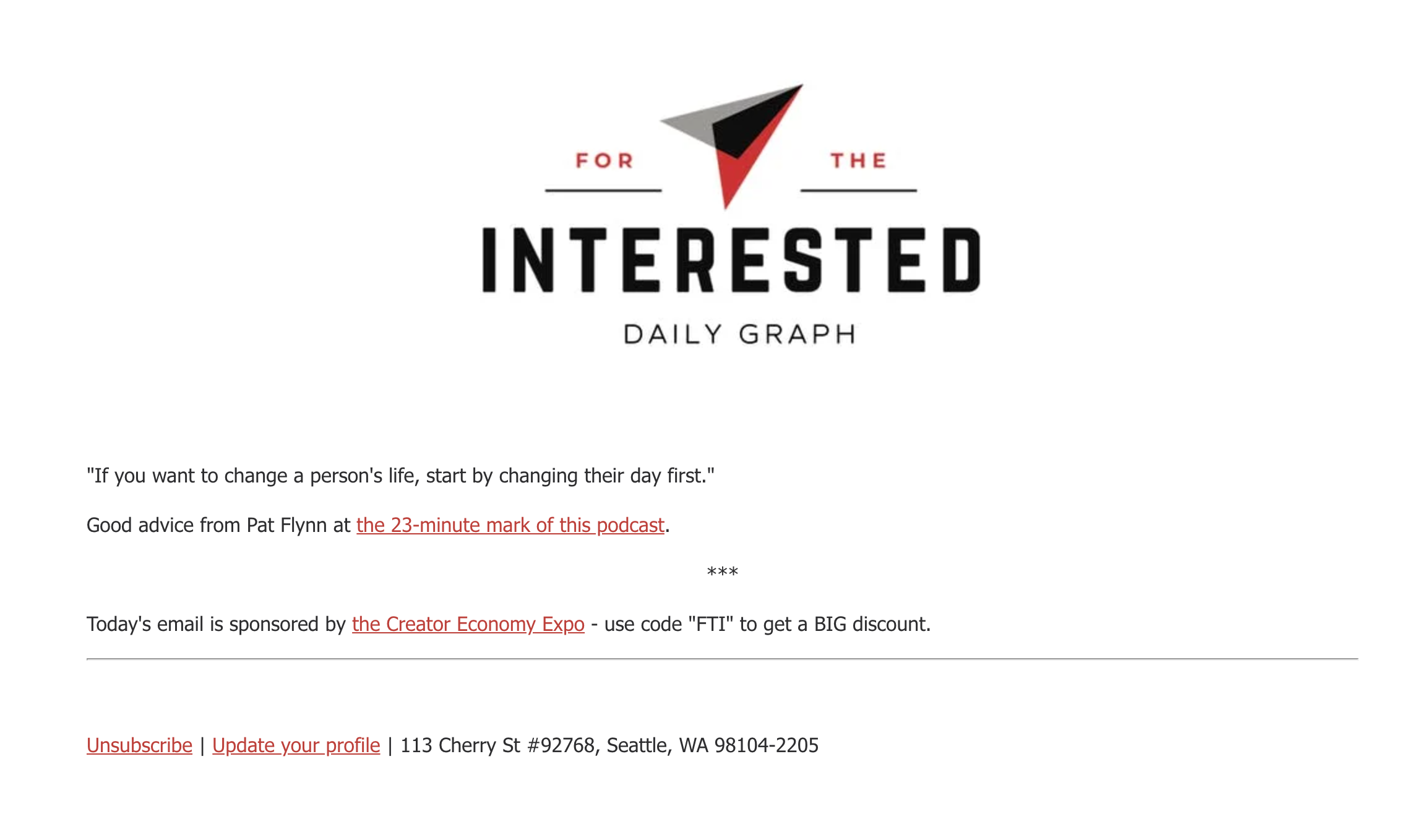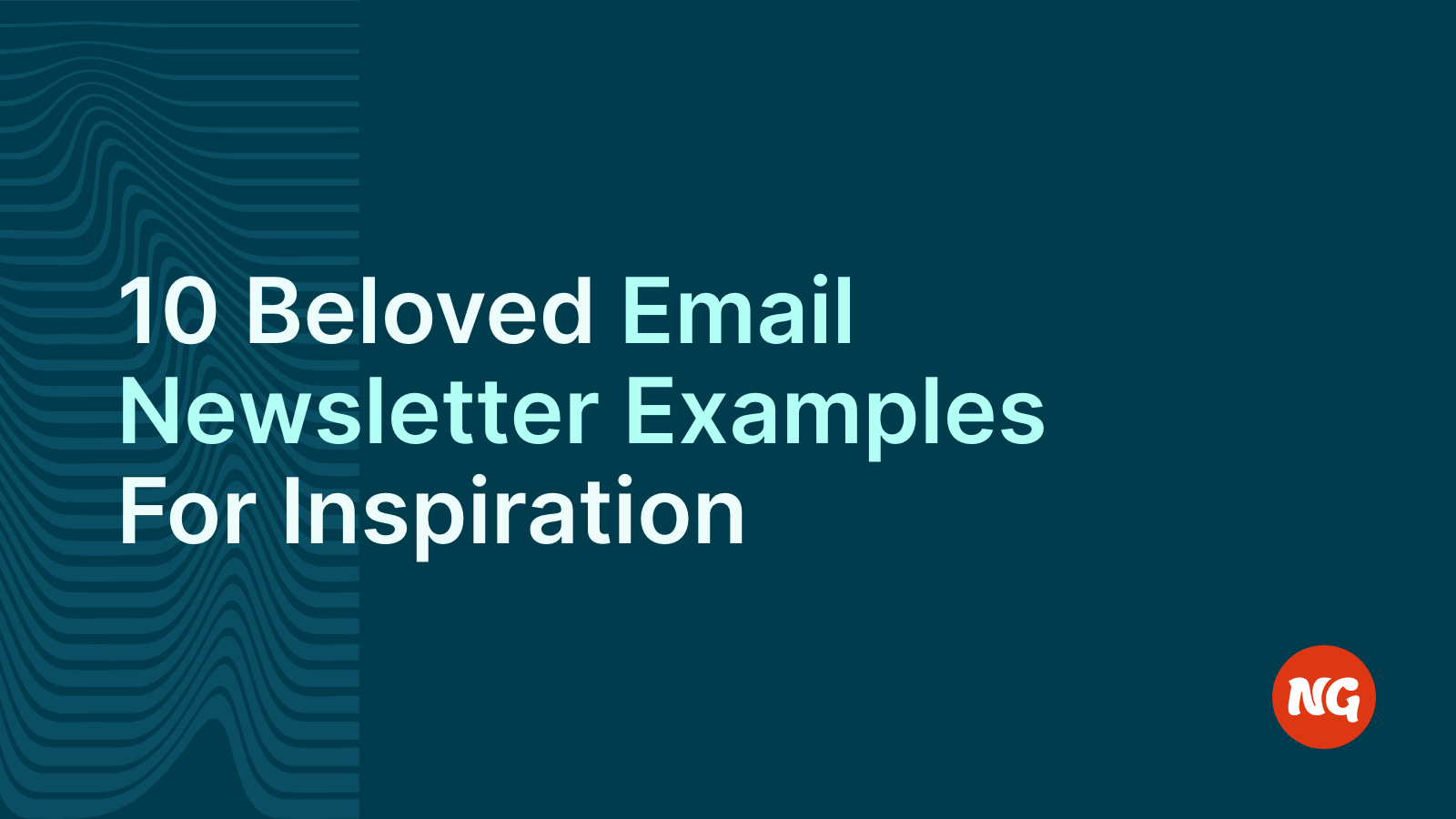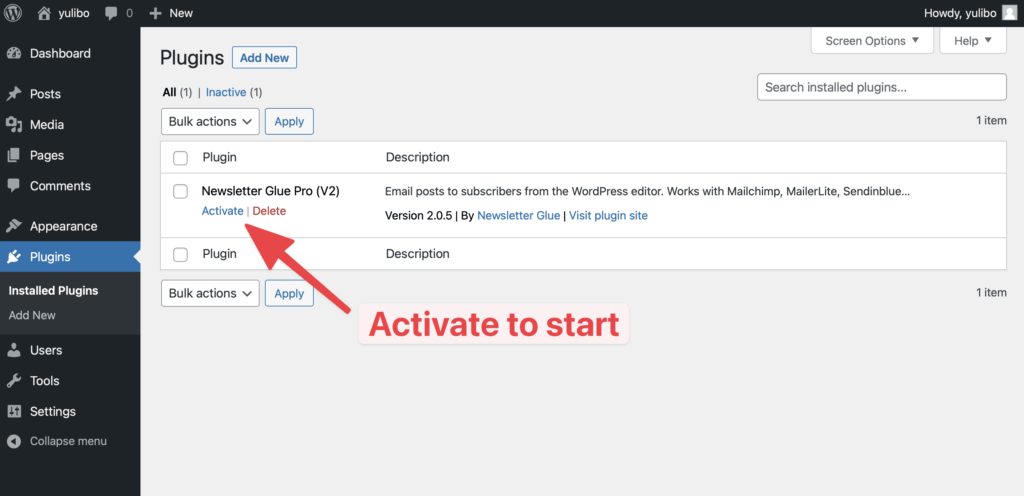“How can I improve my open rates?”
There are many variables from deliverability to email clients that are out of your control. However, one thing that is in your control is creating a great newsletter.
And one of the best ways to do that is by looking at examples of popular email newsletters, figuring out the best practices, and reverse engineering what works.
In this newsletter, we’ll learn from 10 prolific newsletters:
- Morning Brew
- Annarchy by Ann Handley
- For The Interested by Josh Spector
- Dense Discovery by Kai Brach
- Refind by Dominik Grolimund
- Trends.vc by Dru Riley
- Wonder Tools by Jeremy Caplan
- 3-2-1 Thursday Newsletter by James Clear
- Sunday Snippets by Ali Abdaal
- Maker Mind by Anne-Laure Le Cunff
What you can learn from studying email newsletter examples
When done right, studying many different email newsletters will help you:
- Get new design ideas
- Figure out your copywriting style and voice
- Improve your newsletter’s structure and formatting
- Get inspiration for new sections for your newsletter
- Have more points of reference, so that you’re not limited to the few newsletters you personally subscribe to.
And at the end of it, you’ll have lots of ideas you can takeaway to improve your newsletter and its open rates.
1. Morning Brew
Category: Business
According to their landing page, Morning Brew is a free daily email newsletter that makes reading the news actually enjoyable.
They also have other niche newsletters called Emerging Tech Brew, Marketing Brew, Retail Brew, Sidekick, Money Scoop, and HR Brew.
Collectively, they have over 3+ MILLION subscribers! That’s approximately the size of countries like Armenia, Qatar, and Puerto Rico (source). This means they must be doing something right. Something that resonates with millions of readers.
Let’s take a look at their most recent newsletter.
Tips you can steal from Morning Brew’s email newsletter example:
- Friendly + fun language: Business newsletters are usually dry and stuffed with statistics. This is where Morning Brew shines by adding fun, friendly, and sometimes quirky language while writing their newsletter. Remember that your readers are humans too, and they love it when you sound like a normal person in their personal inbox instead of like a TV News Anchor.
- Branded section Headlines: If you scroll down, you’ll notice headlines like “What’s brewing?” and “Brews Bets”. With innovative branded headlines, Morning Brew’s readers will remember them whenever they hear the word “brew”. You can come up with creative wordplays like this and own them in your newsletter. (Psst! I have a section called “Curious Pick” for my newsletter “The Curious Bunch” 😉)
- Make each section shareable: You’ll see that they have social sharing icons for each news section in their newsletter. This allows subscribers to specifically share a piece of news that resonates with them, without having to share the whole newsletter. Any time you can help your subscribers look smart or make their lives easier, do it!

2. Annarchy by Ann Handley
Category: Marketing
I have never seen a marketing newsletter as fun and informative as Annarchy. Ann Handley, a WSJ Best-selling author, has been writing her bi-weekly newsletter for almost 4 years now. Her newsletter grew to tens of thousands of subscribers in a very short period.
What makes her newsletter different from other marketing newsletters?
Tips you can steal from Ann Handley’s Annarchy email newsletter example:
- Personalization: A common misconception among newsletter writers is that the only personalization they know and use is by adding the “name” of the reader to the end of a sentence or a question. Despite not using names, Ann goes above and beyond to personalize her introductions, sections, and questions. Notice how she calls me (the reader) a hotshot! 🤯 This is followed by her quirky and fun poem that ties back to her audience, i.e., marketers. Don’t just use your readers’ names when you send your next issue; speak to them directly and sound like you’re excited to be in their inbox. It works wonders!
- Love Letters a.k.a Mini shout-outs: One of the ways Ann Handley acknowledges her fans and super fans is by giving them space in her newsletter in the form of “love letters” a.k.a “mini shout-outs”. ****This has a trickle-down effect on your readers and makes them want to share your newsletter on social media and brag about you!

3. For The Interested by Josh Spector
Category: Creators
Josh Spector, a marketing and business consultant, writes a free weekly email newsletter featuring ideas to help you produce, promote, and profit from your creations.
He’s one of the most prolific writers I’ve come across during my online writing journey. He writes a blog, a Medium Publication with 32,000 followers, and runs a paid newsletter + skill sessions for creators.
Tips you can steal from For The Interested email newsletter example:
- Curated Resources: If you’re finding it difficult to write an original long-form newsletter every single week, then you might want to consider sharing curated resources from your niche. Summarize the link you’re sharing and offer value upfront instead of using a click-bait CTA.
- Length of the newsletter: Notice how clear Josh is about sharing only 5 ideas? Compared to our previous examples, this is probably one of the shortest newsletters. Remember that the length of your newsletter doesn’t matter as long as you provide value and solve specific problems for your readers. Next time you send a newsletter, put yourself in the reader’s shoes and ask if you would read every single line of your newsletter. If the answer is no, then remove the unnecessary parts.

4. Dense Discovery by Kai Brach
Category: Creatives, Curated
Dense Discovery is a free weekly email newsletter with fresh discoveries at the intersection of design, technology, sustainability and culture. Kai Brach has grown his newsletter from 0 to 35,000 subscribers in less than 3 years. The best thing about this newsletter? It’s curated, opinionated, and full of surprises.
It’s also so insanely long, we had to split up the screenshots into 3! This doesn’t mean it’s boring though, Dense Discovery is rich with images and GIFs and very well structured, so readers never feel bored or lost when reading.
Tips you can steal from the Dense Discovery email newsletter example:
- Design and Format: One of the things you’ll notice about Dense Discovery is its colourful design and how clearly it is formatted so I can skim the content quickly. It does not mean I skip reading, but it is so easy on my eyes that I find myself scrolling to the end of the newsletter. It is important to create or modify your email template’s design to make it easy for your readers to read.
- Interviews + not-so-boring ending: One of the unique ways to come up with original content is to take short interviews with noted people and introduce them to your readers in a digestible format. Ensure it is relevant to your readers so they will take an interest in learning more about the person you’re interviewing. The end of most newsletters is usually boring with contact info or a simple thank you. Take a leaf out of Kai’s newsletter. End it with a fun fact and an even funnier GIF! Like I said, add personality to your newsletter.



Link to Dense Discovery newsletter
5. Refind by Dominik Grolimund
Category: Automated Curation
Refind is a fast-growing bookmark + content curation platform. Every day, they pick 7 links that make you smarter, tailored to your interests, and curated from more than 10,000 sources.
Tips you can steal from the Refind email newsletter example:
- Automate Curation: If you have thousands of links in your database or a business with many resources to share with your users and customers, then automating the curation process is the faster way to stay in touch with them. It ensures you’re always at the top of their minds and establishes you as an authority in your niche.
- Freedom to choose cadence: Most readers do not want to get bombarded with emails every single day. Some might even change their minds along the way. That doesn’t mean they don’t want to receive your emails altogether. It simply means they want to reduce the number of emails they receive. Allow them to choose whether they would like to receive a daily, weekly, or monthly newsletter. Originally, I chose to receive Refind every day, but I have changed my mind multiple times over the last few months. Giving this option to subscribers reduces churn significantly.
.png?table=block&id=71b4e3f1-dad8-41f6-baad-a7436d240fb6&spaceId=0c2ad7cb-33c7-45a9-9d73-fb886e1b27b7&width=980&userId=&cache=v2)
.png?table=block&id=d9330dcb-6b2c-460f-be86-e5fa0e604072&spaceId=0c2ad7cb-33c7-45a9-9d73-fb886e1b27b7&width=1000&userId=&cache=v2)
6. Trends.vc by Dru Riley
Category: Market Research, Reports
Every once a week, Dru Riley shares new emerging markets and ideas with 50,000+ entrepreneurs. He condenses several hours of research into 5-minute reports so you don’t have to waste your time browsing and getting lost.
Tips you can steal from Trends.vc email newsletter example:
- Collaborate with your readers, friends, or the community: Trends is created with the help of its readers, friends, and community. Before Dru Riley sends an issue, he tweets asking who should he talk to in XYZ niche? By involving the community in creating your newsletter, you not only increase word-of-mouth and subscribers, but you also make your newsletter more authentic, and you cannot duplicate the work that goes into it.
- Tease your paid content naturally: If you want to monetize your newsletter, one of the best ways to do so is to paywall some of the original content you create. Use the end of the issue to introduce your free subscribers to the paywalled content. Tease them with what’s inside and what they can expect once they become a paid subscriber. Create a sense of community that makes them feel like more than just another paid subscriber.
.png?table=block&id=7dcdc614-134d-45a6-b586-46c320deb4a4&spaceId=0c2ad7cb-33c7-45a9-9d73-fb886e1b27b7&width=1020&userId=&cache=v2)
.png?table=block&id=ae73fde7-ae3e-4726-9030-b1c5591949f0&spaceId=0c2ad7cb-33c7-45a9-9d73-fb886e1b27b7&width=980&userId=&cache=v2)
.png?table=block&id=60b0fcee-113d-47f8-b30f-e96bfaa8b80c&spaceId=0c2ad7cb-33c7-45a9-9d73-fb886e1b27b7&width=1000&userId=&cache=v2)
7. Wonder Tools by Jeremy Caplan
Category: Tools, Products
If you’re into affiliate marketing or simply someone who enjoys reviewing products and providing useful + actionable info for your readers, then this one is for you!
Wonder Tools is a free newsletter that highlights new sites, apps, and other online services from an independent perspective.
Tips you can steal from Wonder Tools email newsletter example:
- Review tools and products related to one topic: In every issue, Jeremy reviews tools and products that help his readers solve one specific problem. In the issue below, he explains how his readers can create their own newsletters. You can take this a step further and review tools that will bring you affiliate income. Win-win!
- Be transparent with advantages and limitations: More than anything, readers respect when someone is fully transparent with their suggestions. Whenever you suggest a tool make sure you also include its disadvantages or limitations along with its advantages. You’ll eventually win the trust of your readers and they’ll become your biggest fans. I promise.
.png?table=block&id=224d6547-2122-4d4f-93e6-9a130d68de1c&spaceId=0c2ad7cb-33c7-45a9-9d73-fb886e1b27b7&width=1900&userId=&cache=v2)
8. 3-2-1 Thursday Newsletter by James Clear
Category: Thought Leadership
James Clear is the author of the #1 New York Times bestseller, Atomic Habits, which has sold more than 5 million copies worldwide. He also writes a free weekly newsletter called “3-2-1” every Thursday that goes out to 1 MILLION subscribers! So, what can we learn from him?
Tips you can steam from James Clear’s 3-2-1 Thursday email newsletter example:
- Original Thoughts + Sharing on Social Media: Want to establish thought leadership in your niche? It’s time for you to roll up your sleeves and share bite-sized thoughts from your work experience or personal experience. They don’t have to be 2000 words long. They can also be one-sentence tweets, but make sure that it’s something that makes the reader “think” about what you just shared. Don’t forget to make it easy for your readers to share these thoughts on social media with a shortcut link.
- Ask Questions: Get people to take action by asking questions. James Clear does this cleverly by asking one thought-provoking question every Thursday to his readers. You can also go a step further by asking your readers to reply with their answers directly to you via email. It helps you build a 1:1 relationship with your readers.
.png?table=block&id=013e4786-3d1e-4382-aa15-78f5c0347f58&spaceId=0c2ad7cb-33c7-45a9-9d73-fb886e1b27b7&width=2000&userId=&cache=v2)
9. Sunday Snippets by Ali Abdaal
Category: Personal
Ali Abdaal is a successful doctor, YouTuber, and podcaster. He shares actionable productivity tips and practical life advice in his weekly email newsletter.
Ali Abdaal’s newsletter is one of the best examples you could pick if you’re a creator or an influencer looking to stay in touch with your audience.
Tips you can steal from Sunday Snippets email newsletter example:
- Share what you learned: I enjoy the way Ali shares personal experiences in his newsletter. There is a lot of advice out there either optimized for SEO or to get more views by getting you to click on the title. You rarely find creators sharing advice based on their personal journey. This helps you connect with your reader on a personal level.
- Promote your other newsletters: If you’re a YouTuber who shares productivity advice but not necessarily about ‘How To Create Videos’, even though you are an expert, use this opportunity to segment your audiences and cross-promote between them. See how Ali does it below with a simple “PS”. Later, you can use this sub-list to share free resources about creating videos, sell your courses or info-products, and in general serve a super-specific niche.
.png?table=block&id=9b9e0218-78a0-4ac4-a128-522d968a3636&spaceId=0c2ad7cb-33c7-45a9-9d73-fb886e1b27b7&width=1830&userId=&cache=v2)
10. Maker Mind by Anne-Laure Le Cunff
Category: Mindful Productivity
Maker Mind is your weekly dose of mindful productivity. Anne-Laure shares neuroscience-based strategies to cultivate your curiosity and maximise your productivity. She has grown her newsletter from 0 to 40,000 subscribers in a span of 3 years and she has 1000s of members in her paid community.
Let’s see what we can learn from her!
Tips you can steal from Maker Mind email newsletter example:
- High standards for sponsors: One thing you need to keep in mind while writing a free newsletter is that it’s totally okay if you want (or don’t want) to eventually monetize it. An important unwritten rule when it comes to accepting sponsors is that they should be relevant to your audience. Imagine a sponsored ad from a food-related brand in a marketing newsletter. How odd is that!? No one benefits from that. You don’t want to create a lose-lose situation when accepting sponsors for your newsletter.
- It doesn’t have to be “just” a newsletter: Anne-Laure not only shares curated links and original articles, but she also uses her newsletter as a distribution channel for her YouTube videos and other creative pursuits. While you may find this surprising, most readers know and accept when you try to sell them something. Just make sure you’re not too sales-y or pushy while doing that. Providing value to your reader should always be your top priority.
.png?table=block&id=8d6de62c-52c4-4889-8c44-dce3ed7562e6&spaceId=0c2ad7cb-33c7-45a9-9d73-fb886e1b27b7&width=1390&userId=&cache=v2)
.png?table=block&id=175c2b4e-75ed-4e00-977d-2bf6d654338d&spaceId=0c2ad7cb-33c7-45a9-9d73-fb886e1b27b7&width=1390&userId=&cache=v2)
.png?table=block&id=b216c981-76f5-42d0-9ede-c58eb27326ab&spaceId=0c2ad7cb-33c7-45a9-9d73-fb886e1b27b7&width=1390&userId=&cache=v2)
.png?table=block&id=84b43b04-2224-4fce-a533-4ccbc99dd397&spaceId=0c2ad7cb-33c7-45a9-9d73-fb886e1b27b7&width=1410&userId=&cache=v2)
Link to Ness Labs newsletter sample
Ready to start your Email Newsletter? Here are some tips to get you started:
- Consistency matters more than frequency. The more you become used to your reader’s inbox, the more they’ll relate to what you have to say and share. Become a habit for your reader by showing up regularly.
- Choose a cadence that works for you and one that doesn’t burn you out. Most writers overcommit, leading to sporadic rather than consistent publishing.
- Don’t face a blank page. Use Newsletter Glue’s Email Template builder to customize a format and design for your needs. All you need to do is add the links or text you want to share with your readers.
- Schedule your newsletter or have a backup newsletter ready. Another great way to make sure that you don’t skip sending out a newsletter is scheduling it in advance. Newsletter Glue also comes with a scheduling feature that you can use to target specific segments or lists.
- Don’t overcommit. Follow the KISS Method. Keep It Simple, Stupid! Don’t write about too many things. Make sure your newsletter addresses specific problems (or a set of problems) for your readers.
- Find accountability partners. Announce that you’d be sending a newsletter in the next few hours on Twitter. Ask your friend to follow up with you about your next issue. Or, if you’re like me, book a sponsor. There’s no way you’ll skip sending an issue when there’s money on the line. 😅
Takeaways
At the end of the day, you know the value you’d be getting if you started a newsletter. All you’ve to do is start it the right way!
Here are some of the important takeaways from this post:
- Morning Brew: Use friendly + fun language. Make each section shareable.
- Annarchy by Ann Handley: Give shout-outs to those who share your content or acknowledge your efforts.
- For The Interested by Josh Spector: The length of the newsletter doesn’t matter.
- Dense Discovery by Kai Brach: The design and format of a newsletter are underrated.
- Refind by Dominik Grolimund: Automate your curation.
- Trends.vc by Dru Riley: Tease your paid content naturally.
- Wonder Tools by Jeremy Caplan: Be transparent with the advantages and limitations of products or links you’re sharing.
- 3-2-1 Newsletter by James Clear: Get people to take action by asking questions.
- Sunday Snippets by Ali Abdaal: Use your list to segregate your audience and provide value to a super-specific niche.
- Maker Mind by Anne-Laure Le Cunff: Use your newsletter as a distribution channel and not “just” a newsletter.


